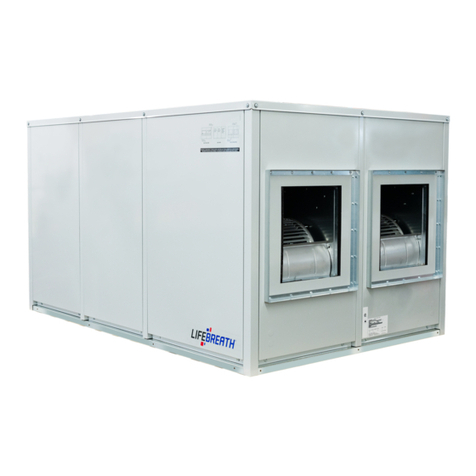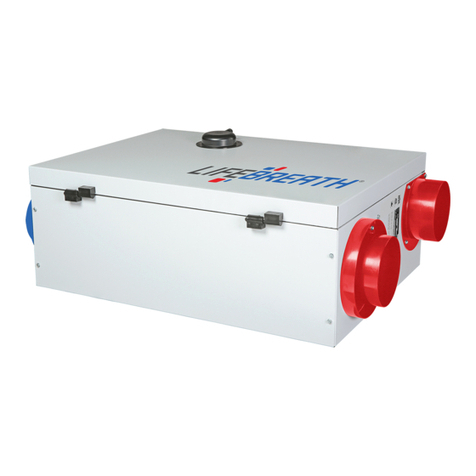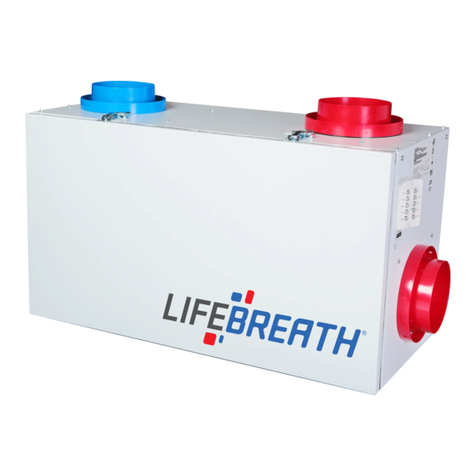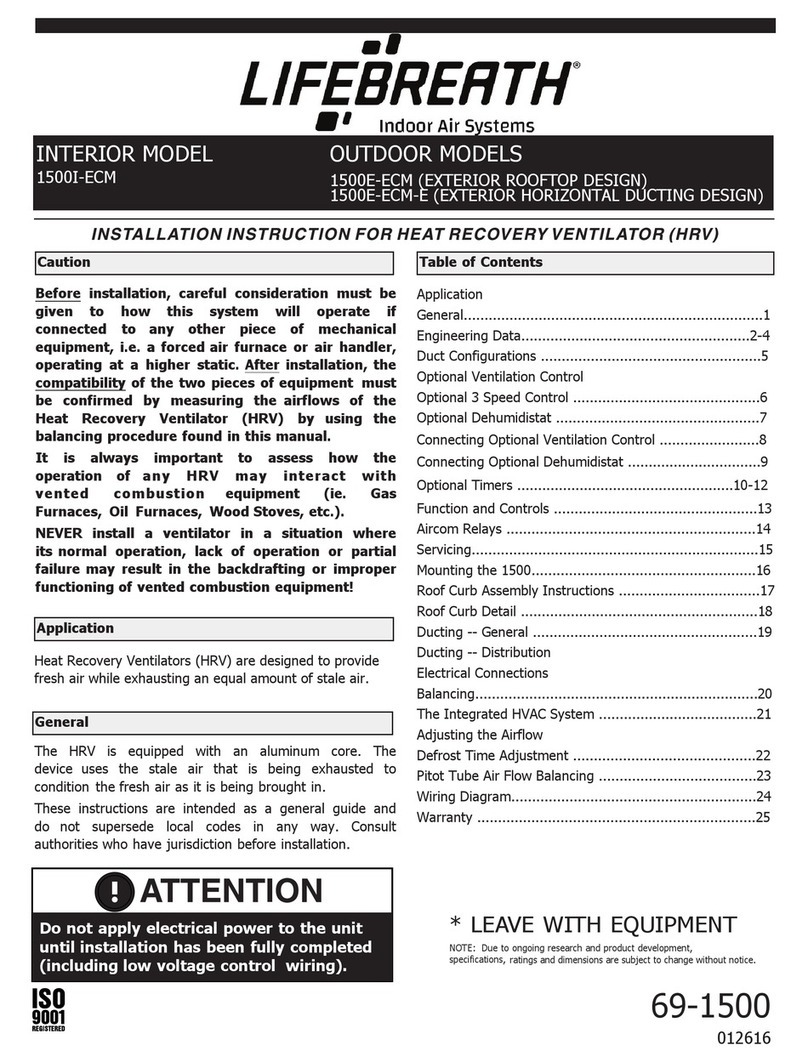
3
49"
(1245 mm)
8"
(200 mm)
FRONT VIEW
18 3/4"
(475 mm)
28 1/4"
(717 mm)
14"
(356 mm)
5 7/8"
(150 mm)
1 1/4"
(32 mm
)
INTERIOR DUCT
CONNECTION SIDE
18 3/4"
(475 mm)
8"
(200 mm)
28 1/4"
(717 mm)
14"
(356 mm)
5 7/8"
(150 mm)
1 3/8"
(35 mm)
EXTERIOR DUCT
CONNECTION
SIDE
MOUNTING POINTS
EXHAUST AIR
TO OUTSIDE
EXHAUST AIR
FROM BUILDING
SUPPLY AIR
TO BUILDING
SUPPLY AIR
FROM OUTSIDE
NOTE:
Service
clearance
is
30
in.
(760
mm)
DRAIN CONNECTION
DEFROST
CORES
Two modular (two section) aluminum HRV cores arranged for high efficiency cross-flow ventilation.
MOTORS
Two PSC, 5 speed double shafted, 120 VAC, 3.15 A motors. (6.3 A total on high speed) with 1/10
hp at 1625 RPM. Total of 610 watts on High speed. MCA: 7.9 MOP:10
BLOWERS
Centrifugal-type rated at 530 cfm (250 L/s) free air delivery. Each air stream has two centrifugal
blowers driven by two PSC motors.
FILTERS
Washable air filters in exhaust and supply air streams.
DEFROST
Supply bypass damper routes indoor air to defrost cores.
WEIGHT 160 lbs. (70 kg) SHIPPING WEIGHT 240 lbs. (110 kg)
CONNECTION DUCT SIZES
Four 14”x 8” ( 356 mm x 200 mm)
MOUNTING
Unit to be set on support brackets hung by threaded rod-type apparatus (brackets and rods not
included).
CASE
Twenty gauge pre-painted galvanized steel (G60) for superior corrosion resistance. Insulated with
foil faced insulation duct liner where required to prevent exterior condensation. One drain
connection 1/2" (12 mm) OD.
ELECTRONICS
Integrated microprocessor circuit board. Built-in interlock contacts.
Date: ___________________________________________
Tag: _____________________Qty:___________________
Project: _________________________________________
Engineer: _______________________________________
Contractor: ______________________________________
Supplier: ________________________________________
Quote#: _________________________________________
Submitted by: ____________________________________
PERFORMANCE
Net
supply
airflow
in
cfm
(L/s)
against
external
static
pressure
E.S.P cfm L/s
@ 0.1” (25 Pa) 450 (212)
@ 0.2” (50 Pa) 426 (201)
@ 0.3” (75 Pa) 400 (189)
@ 0.4” (100 Pa) 371 (175)
@ 0.5” (125 Pa) 337 (159)
@ 0.6” (150 Pa) 304 (143)
@ 0.7” (175 Pa) 269 (127)
@ 0.8” (200 Pa) 158 (75)
@ 0.9” (225 Pa) 107 (50)
VAC @ 60HZ 120
WATTS / Low speed 187
WATTS / High speed 610
Amp rating 6.3
AIRFLOWS (Each Air Stream)
250
200
150
100
50
0.1 0.2
100%
90%
80%
300
(143)
400
(190)
500
(235)
600
(282)
AIRFLOW IN CFM (L/s)
NOTE: Exhaust Relative Humidity (RH) at 40%
EFFECTIVENESS
200
(94)
300
5
1
2
3
4
*3 - Medium Speed
*1 - Low speed
*5
*4
-High Speed
-Medium High Speed
*2 - Medium Low speed
0
350
400
450
500
0.3 0.4 0.5 0.6 0.7
EXTERNAL STATIC PRESSURE (inches W.C.)
TEMPERATURE EFFECTIVENESS
0.8 0.9
Specifications 350DCS
AIRFLOW CFM
DIMENSIONS inches (mm)
All units conform to
CSA and UL
standards
NOTE: All
specifications are
subject to change
without notice.
WARRANTY
Units carry a 15 year warranty
on the HRV core and a 2 year
replacement parts warranty.
99-BC03 Lifebreath Ventilation Control
•
•
•
Continuous Low fan speed Humidity
control through adjustable
Dehumidistat
3 modes of operation: Ventilation,
Recirculation, 20/40
•
Compatible with 99-DET02 Wireless
Timers
•
3 wire connection
CONTROL OPTIONS
99-DXPL02 Lifebreath Digital Control
(Included)
•
•
5 speed operation on each mode
Humidity control through adjustable
Dehumidistat
•
5 user selectable operational modes: Continuous
Ventilation, Continuous Recirculation, 20 ON/40
OFF, 10 ON/50 OFF, 20 ON/40 Recirculation
•
20/40/60 min. High speed override
button
•
Compatible with 99-DET02 Wireless
Timers
•
3 wire connection
99-BC02 Lifebreath Ventilation Control
•
2 speed fan setting (Low/High)
•
Humidity control through adjustable
Dehumidistat
•
Compatible with 99-DET02 Wireless
Timers
•
3 wire connection
99-BC04 Lifebreath Ventilation Control
•
2 speed fan setting (Low/High)
•
2 modes of operation: Ventilation, 20/40
•
Compatible with 99-DET02 Wireless
Timers
•
3 wire connection
99-DH01 Lifebreath Dehumidistat
•
Humidity control through adjustable
Dehumidistat
•
3 wire connection
TIMER OPTIONS
99-DET01 Lifebreath 20/40/60 Minute Timer - Initiates High speed Ventilation for 20, 40 or 60 minutes. 3 wire connection.
99-DET02 Lifebreath WIRELESS 20/40/60 Minute Timer - Initiates High speed Ventilation for 20, 40 or 60 minutes.
Wirelessly connects to main control for ease of installation. 40' approximate range.
99-RX02 Lifebreath WIRELESS Repeater - Used to extend range of 99-DET02 Wireless Timers. Plugs into 120V power
outlet. Wirelessly connects to main control and 99-DET02. Install at halfway point between timer and main wall control
if timer is out of range.

































